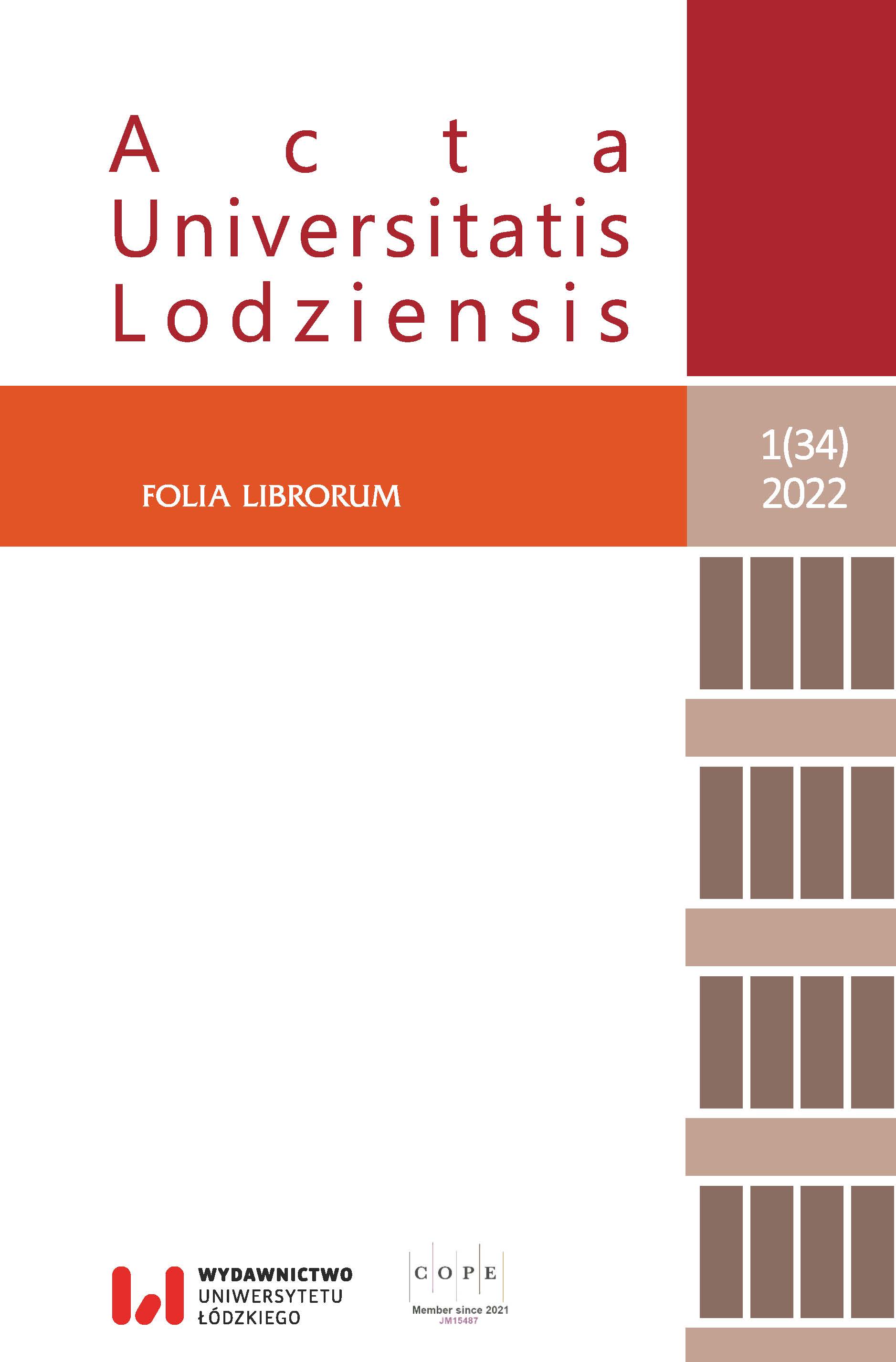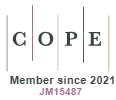Ocena wiedzy, umiejętności i postaw studentów Wydziału Filologicznego Uniwersytetu Łódzkiego w zakresie bezpiecznego korzystania z Internetu
DOI:
https://doi.org/10.18778/0860-7435.34.05Słowa kluczowe:
kompetencje informacyjne, kompetencje cyfrowe, cyberbezpieczeństwo, zagrożenia bezpieczeństwa w InternecieAbstrakt
W artykule podjęto rozważania nad kompetencjami studentów Wydziału Filologicznego Uniwersytetu Łódzkiego w zakresie bezpiecznego korzystania z Internetu. Celem badań było poznanie i ocena wiedzy, umiejętności i postaw studentów w obrębie niezagrożonej konsumpcji treści zamieszczanych i spotykanych w sieci każdego dnia, a także innych aspektów związanych z wyzwaniami cyberprzestrzeni. Zwrócono również uwagę na potencjał kompetencji informacyjnych i cyfrowych, których nie powinno brakować szczególnie (choć nie tylko) osobom studiującym. Kluczowe znaczenie mają zatem: ustawiczny rozwój tych umiejętności, pozyskiwanie wiedzy i świadomość potencjalnych zagrożeń.
Realizacji wyznaczonych celów posłużyły następujące metody badań: metoda krytycznej analizy literatury przedmiotu, metoda bibliograficzna oraz metoda sondażu diagnostycznego. Niezbędne dla zrozumienia istoty problemu i zagłębienia się w tematykę bezpieczeństwa w sieci było przywołanie definicji „cyberprzestrzeni”, „cyberbezpieczeństwa”, „kompetencji cyfrowych” i „kompetencji informacyjnych” oraz scharakteryzowanie wybranych zagrożeń bezpieczeństwa w sieci, czego dokonano dzięki przeglądowi literatury.
W części o charakterze metodologicznym wskazano przedmiot badań, cele i problemy badawcze, określono zasady doboru próby oraz opisano metody, techniki i narzędzia badawcze. Część badawcza stanowi analizę wyników badania ankietowego przeprowadzonego na studentach Wydziału Filologicznego Uniwersytetu Łódzkiego.
Badanie przeprowadzone na reprezentatywnej grupie studentów pozwoliło ustalić, jakich trudności związanych z korzystaniem z Internetu studenci Wydziału Filologicznego Uniwersytetu Łódzkiego najczęściej doświadczają, jakich zagrożeń w sieci obawiają się najbardziej, w jaki sposób studenci chronią swoje zasoby, prywatność i wizerunek w Internecie, z jakich źródeł czerpią wiedzę o cyberbezpieczeństwie i jak oceniają swoje kompetencje w tym zakresie. Z analizy można odczytać, że większość badanych ma podstawową wiedzę niezbędną do odpowiedzialnego korzystania z zasobów Internetu oraz umiejętności korzystania z narzędzi umożliwiających lepszą ochronę w cyfrowej przestrzeni. Zaleca się jednak prowadzenie dalszych badań w tym kierunku.
Pobrania
Bibliografia
Babik, Wiesław (2012). Ekologia informacji katalizatorem równoważenia rozwoju społeczeństwa informacji i wiedzy. Zagadnienia Informacji Naukowej, 2, 48–65, [online]. Pobrano 28 marca 2021 r., z: http://bbc.uw.edu.pl/dlibra/docmetadata?id=1865&from=publication&.
Google Scholar
Furmanek, Waldemar (2014). Zagrożenia wynikające z rozwoju technologii informacyjnych. Dydaktyka informatyki, 9, 20–48, [online]. Pobrano 17 marca 2021 r., z: http://cejsh.icm.edu.pl/cejsh/element/bwmeta1.element.desklight-8cea2630-e302-4479-bdc9-1f829e0539ff/c/Furmanek_1.pdf
Google Scholar
Information Security Threats and Tools for Addressing Them (2019). In: exabeam.com [online], Pobrano 17 marca 2021 r., z: https://www.exabeam.com/information-security/information-security-threats/
Google Scholar
Internet Usage Statistics. The Internet Big Picture (2021). In: Internet World Stats [online]. Pobrano 6 stycznia 2021 r., z: https://www.internetworldstats.com/stats.htm
Google Scholar
Jabłońska, Marta R. (2018). Człowiek w cyberprzestrzeni. Wprowadzenie do psychologii Internetu. Łódź: Wydawnictwo Uniwersytetu Łódzkiego.
Google Scholar
Kaczmarczyk, Barbara, Szczepański, Piotr & Dąbrowska, Marlena (2019). Wybrane zagadnienia cyberbezpieczeństwa. Zeszyty Naukowe Państwowej Wyższej Szkoły Zawodowej im. Witelona w Legnicy, 32(3), 201–210, [online]. Pobrano 9 stycznia 2021 r., z: http://cejsh.icm.edu.pl/cejsh/element/bwmeta1.element.desklight-d9156188-4716-4a21-9ad6-6204c6e5931a
Google Scholar
Kasprzak, Wojciech (2015). Ślady cyfrowe. Studium prawno-kryminalistyczne. Warszawa: Wydawnictwo Difin.
Google Scholar
Kasprzak, Włodzimierz, Szynkiewicz, Wojciech, Stefańczyk, Maciej, Dudek, Wojciech, Figat, Maksym, Węgierek, Maciej, Seredyński Dawid & Zieliński Cezary (2019). Agentowa struktura wielomodalnego interfejsu do Narodowej Platformy Cyberbezpieczeństwa, część 1. Pomiary Automatyka Robotyka, 23(3), 41–54, [online]. Pobrano 9 stycznia 2021 r., z: https://bibliotekanauki.pl/articles/275795
Google Scholar
DOI: https://doi.org/10.14313/PAR_233/41
Kvardova, Nikol, Smahel, David, Machackova, Hana & Subrahmanyam, Kaveri (2021). Who Is Exposed to Harmful Online Content The Role of Risk and Protective Factors Among Czech, Finnish, and Spanish Adolescents. Journal of Youth and Adolescence, 50, 2294–2310, [online]. Pobrano 9 marca 2021 r., z: https://doi.org/10.1007/s10964-021-01422-2
Google Scholar
DOI: https://doi.org/10.1007/s10964-021-01422-2
Lakomy, Miron (2015). Cyberprzestrzeń jako nowy wymiar rywalizacji i współpracy państw. Katowice: Wydawnictwo Uniwersytetu Śląskiego, [online]. Pobrano 6 stycznia 2021 r., z: https://rebus.us.edu.pl/bitstream/20.500.12128/3499/1/Lakomy_Cyberprzestrzen_jako_nowy_wymiar_rywalizacji.pdf
Google Scholar
Lau, Jesús (2011). Kompetencje informacyjne w procesie uczenia się przez całe życie. Wytyczne. Warszawa: Stowarzyszenie Bibliotekarzy Polskich, [online]. Pobrano 12 stycznia 2021 r., z: https://www.ifla.org/files/assets/information-literacy/publications/ifla-guidelines-pl.pdf
Google Scholar
Maciejczuk, Mateusz, Wnorowski, Konrad & Olchanowski, Mateusz (2019). Cyberprzestrzeń a bezpieczeństwo dzieci w świetle rozwiązań Organizacji Narodów Zjednoczonych oraz Rady Europy. Zeszyty Naukowe Zbliżenia Cywilizacyjne, 14(3), 10–34, [online]. Pobrano 6 stycznia 2021 r., z: https://journals.indexcopernicus.com/api/file/viewByFileId/513085.pdf.
Google Scholar
DOI: https://doi.org/10.21784/ZC.2018.020
Marczyk, Maciej (2018). Cyberprzestrzeń jako nowy wymiar aktywności człowieka – analiza pojęciowa. Przegląd Teleinformatyczny, T. 6, 1-2(46), 59–72, [online]. Pobrano 8 stycznia 2021 r., z: http://yadda.icm.edu.pl/baztech/element/bwmeta1.element.baztech-44818be5-0fed-41b3-8d4e-b339ad40a286
Google Scholar
DOI: https://doi.org/10.5604/01.3001.0012.7212
Masrek, Mohamad N., Soesantari, Tri, Khan, Asad & Dermawan, Aang K. (2020). Examining the relationship between information security effectiveness and information security threats. International Journal of Business and Society, 21(3), 1203–1214.
Google Scholar
DOI: https://doi.org/10.33736/ijbs.3335.2020
Matusz, Magdalena (2007). Kompetencje informacyjne uczniów. W: J. Pavelka (red.), Kl’účovékompetencie a technickévzdelávanie. Prešov: FHPV, s. 48–55.
Google Scholar
Motylińska, Paulina (2020a). Bezpieczeństwo informacyjne i medialne w czasach nadprodukcji informacji. Wprowadzenie. W: H. Batorowska & P. Motylińska (red.), Bezpieczeństwo informacyjne i medialne w czasach nadprodukcji informacji. Warszawa: Wydawnictwo Naukowe i Edukacyjne Stowarzyszenia Bibliotekarzy Polskich, s. 11–18.
Google Scholar
Motylińska, Paulina (2020b). Profilaktyka i kształtowanie świadomości w zakresie bezpieczeństwa informacyjnego w środowisku nadmiarowości informacji. W: H. Batorowska & P. Motylińska (red.), Bezpieczeństwo informacyjne i medialne w czasach nadprodukcji informacji. Warszawa: Wydawnictwo Naukowe i Edukacyjne Stowarzyszenia Bibliotekarzy Polskich, s. 201–222.
Google Scholar
Musiał, Emilia (2020). Zagrożenia bezpieczeństwa informacyjnego w kontekście nadmiarowości informacji. W: H. Batorowska & P. Motylińska (red.), Bezpieczeństwo informacyjne i medialne w czasach nadprodukcji informacji. Warszawa: Wydawnictwo Naukowe i Edukacyjne Stowarzyszenia Bibliotekarzy Polskich, s. 177–200.
Google Scholar
Ogonowska, Agnieszka (2016). Kompetencje cyfrowe we współczesnej cywilizacji medialnej. Annales Universitatis Paedagogicae Cracoviensis, 8(2), 14–26, [online]. Pobrano 11 stycznia 2021 r., z: http://cejsh.icm.edu.pl/cejsh/element/bwmeta1.element.desklight-b06b7d89-e5ca-4144-b0e7-3e53ccad5be1/c/de_Cultura_VIII__2__.14-26.pdf
Google Scholar
Prensky, Mark (2001). Digital Natives, Digital Immigrants. On the Horizon, 9(6), 1–6, [online]. Pobrano 11 stycznia 2021 r., z: https://www.marcprensky.com/writing/Prensky%20-%20Digital%20Natives,%20Digital%20Immigrants%20-%20Part1.pdf
Google Scholar
DOI: https://doi.org/10.1108/10748120110424816
Stachowiak, Beata (2009). Kompetencje kluczowe studentów w kontekście oczekiwań społeczeństwa informacyjnego. W: A. Szeląg (red.), Kompetencje absolwentów szkół wyższych na miarę czasów. Wybrane ujęcia. Wrocław: Oficyna Wydawnicza ATUT, s. 111–119.
Google Scholar
Wasilewski, Janusz (2013). Zarys definicyjny cyberprzestrzeni. Przegląd bezpieczeństwa wewnętrznego, 9(5), 225–234, [online]. Pobrano 6 stycznia 2021 r., z: https://www.abw.gov.pl/pl/pbw/publikacje/przeglad-bezpieczenstwa/987,Przeglad-Bezpieczenstwa-Wewnetrznego-nr-9-5-2013.html
Google Scholar
Węgrzyn-Odzioba, Liliana (2018). Zagrożenia bezpieczeństwa społecznego związane z funkcjonowaniem w cyberprzestrzeni. Teka Komisji Politologii i Stosunków Międzynarodowych, 13(2), 77–96, [online]. Pobrano 9 stycznia 2021 r., z: https://journals.umcs.pl/teka/article/download/9435/6555
Google Scholar
DOI: https://doi.org/10.17951/teka.2018.13.2.77-96
Pobrania
Opublikowane
Jak cytować
Numer
Dział
Licencja

Utwór dostępny jest na licencji Creative Commons Uznanie autorstwa – Użycie niekomercyjne – Bez utworów zależnych 4.0 Międzynarodowe.










